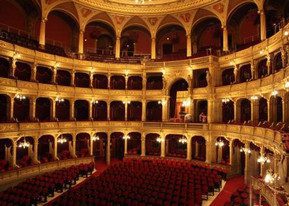What is Znamenny chant: meaning, history, types
Contents
Russian church music began with znamenny chant, which arose during the baptism of Rus’. Its name is associated with the use of special notation symbols – “banners” – for its recording. Their intricate names are associated with a graphic image: bench, darling, cup, two in a boat, etc. Visually, banners (otherwise known as hooks) are a combination of dashes, dots and commas.
Each banner contains information about the duration of the sounds, their number in a given motive, the direction of the sound of the melody and the features of the performance.
The intonations of the znamenny chant were learned by singers and church parishioners by hearing from the masters of znamenny chant, since the exact pitch of the znamenny chant was not recorded. Only in the 17th century. The appearance of special cinnabar (red) marks in the texts made it possible to designate the pitch of hooks.
The spiritual component of Znamenny chant
It is not possible to understand what Znamenny chant is and appreciate its beauty without referring to the spiritual significance of chant in Russian Orthodox culture. Samples of znamenny melodies are the fruits of the highest spiritual contemplation of their creators. The meaning of znamenny singing is the same as that of the icon – liberation of the soul from passions, detachment from the visible material world, therefore the ancient Russian church unison is devoid of chromatic intonations that are needed when expressing human passions.
An example of a chant created on the basis of the Znamenny chant:
S. Trubachev “The Grace of the World”
Thanks to the diatonic scale, the Znamenny chant sounds majestic, dispassionate, and strict. The melody of a single-voice prayer chant is characterized by smooth movement, noble simplicity of intonation, clearly defined rhythm, and completeness of construction. The chanting is in perfect harmony with the spiritual text being sung, and singing in unison focuses the attention of the singers and listeners on the words of the prayer.
From the history of Znamenny chant
Znamenny notation example
To reveal more fully what Znamenny chant is, turning to its origins will help. Znamenny church singing originates from ancient Byzantine liturgical practice, from which Russian Orthodoxy borrowed the annual circle of osmoglasiya (the distribution of church chants into eight singing voices). Each voice has its own bright melodic turns, each voice is designed to reflect different moments of a person’s spiritual states: repentance, humility, tenderness, delight. Each melody is associated with a specific liturgical text and is tied to a specific time of the day, week, or year.
In Rus’, the chants of Greek singers gradually changed, incorporating the features of the Church Slavonic language, Russian musical intonations and metrhythms, acquiring greater melodiousness and smoothness.
Types of znamenny chant
When asking the question of what znamenny chant is and what varieties of it are known, one should look at it as a single musical system that embraces the Znamenny, or pillar (eight voices form a “pillar” set of melodies, repeated cyclically every 8 weeks), traveler and demestine chants. All this musical matter is united by a structure based on chants – short melodic turns. The sound material is built on the basis of the liturgical rite and the church calendar.
Travel chant is a solemn, festive singing, which is a complicated and transformed type of pillar chant. The travel chant is characterized by rigor, firmness, and rhythmic virtuosity.
Of the named style varieties of znamenny singing, the demesnic chant is not included in the book of Octoechos (“eight-harmony”). It is distinguished by the solemn nature of its sound, it is presented in a festive style, it is used to sing the most important liturgical texts, hymns of hierarchal services, weddings, and the consecration of churches.
At the end of the 16th century. the “big znamenny chant” was born, which became the highest point in the development of Russian znamenny singing. Extended and chanting, smooth, unhurried, equipped with an abundance of extensive melismatic constructions with rich intra-syllable chants, the “big banner” sounded at the most significant moments of the service.





